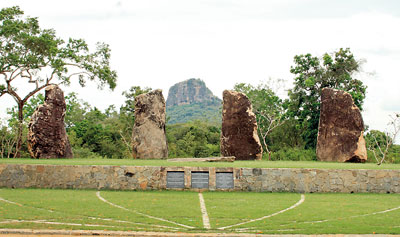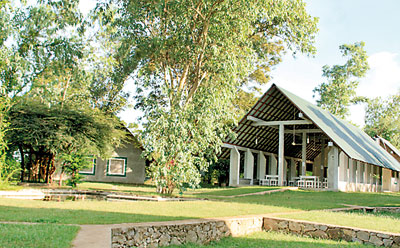Nature’s silent tribute
Standing tall like an oasis in the middle of the harsh landscapes of the East is theThoppigala Heritage Park where one of the most significant battles of Eelam War 1V was fought.
The road past Valaichchenai to Thoppigala is a dusty, beaten track flanked by vast expanses of russet paddy fields, dotted by the occasional palm tree. Everything else is a crisp shade of brown owing to the unforgiving heat, but the villagers who pass by on their bicycles with towering stacks of firewood are full of smiles. The war which cast a pall on the area is no more – in its place are glimpses of opportunity, as the people begin to find a foothold in life.

The path to Thoppigala: From batlleground to conservation. Pix by Indika Handuwala
The path to Thoppigala -the LTTE’s last stronghold in the East- is now open to those who are willing to explore its rich biodiversity. With the recent opening of the ‘Thoppigala Heritage Park’-a collective effort of Dilmah Conservation and the Sri Lanka Army’s Eastern Command- much emphasis has been placed on conservation and tourism in the area.
Located some 40 km north-west of Batticaloa, Thoppigala was a much talked about landmark, due to its strategic importance in Eelam War IV. Being the last Tamil Tiger stronghold to fall after troops penetrated the thick jungle, Thoppigala is symbolic of a great victory.
“The initial concept was to create a monument that would commemorate the valiant soldiers who laid down their lives during the capture of Thoppigala, but at the same time we wanted to take a holistic approach in honouring all those were caught up in the conflict, including the civilian populations,” said a Director at Dilmah, Dilhan Fernando. “The final outcome that we had in mind was to empower livelihood development and help the people of the area resurface from an almost unimaginable state of limbo, while striking a balance between the biodiversity and humanitarian aspects.”
Thus was born the ‘Thoppigala Heritage Park’ standing tall like an oasis in the middle of the harsh landscapes of the East watched over by the Army’s 232 Brigade. Brigade Commander, Brigadier Sena Waduge updates us on the recent happenings in the area. Now the ‘terrorism’ is by wild elephants who seem to be strategically uprooting gunny bags and embankments put up by the Army. “It’s almost like we should consult them before building anything,” laughs Brigadier Waduge.
At Alioluwa Junction, lies the magnificent Thoppigala Monument, considered the biggest in Sri Lanka, constructed with financial assistance from Dilmah Conservation. The concept of the four giant boulders signify the forces involved in the fight till victory, while an artistic representation of lines represent peace emanating from the motherland.

The four boulders: Remembering the forces involved in the landmark battle
The Sri Lanka Army provided the labour for its construction under the supervision of Security Forces Commander-East, Lal Perera, 23 Divisional Commander, Brigadier Athula Kodippili, and 232 Brigade Commander Sena Waduge, while Nihal Bodhinayake Associates extended the architectural assistance.
The park also has both holiday bungalows and a campsite. On the way to the campsite, large structures loom above the line of shrub forest – the information centre of the ‘Thoppigala Heritage Park’.
The information centre houses a series of models that depicts the various stages of the battles that unfolded in these areas. Informative panels on either side house descriptions of the weapons used in combat – the ingenious explosive devices used by the LTTE such as the 360 radius claymore mine, and the notorious Johnny Batta are displayed.
Also displayed is information of the area’s biodiversity with a strong message of conservation. Thoppigala has four of the 14 different ecosystems found in Sri Lanka; the Dry Mixed Evergreen forest with trees such as Palu, Burutha, Weera and Halmilla, the Dry Riverine Evergreen forest with terrestrial vegetation by the river, the Sparse and Open forest, with flourishing kohomba (margosa) and Ehela trees, and also the Dry Patana Grassland which is home to many types of grasses.
“We have initiated a replanting process where over 20,000 indigenous trees have been planted while a twin objective was achieved by planting cash crops such as cashew so that the villagers can have a sustainable livelihood,” explained Dilhan Fernando.
The track that leads to the camping site is through grass chest high and thick trees- a typical dry-zone habitat.
“Thoppigala is an area of utmost importance as a dry-zone, since you get all the species that are found to be living in the dry-zone,” says Head of the Department of Zoology, University of Colombo, Prof. Sarath Kotagama. “The landscape is shaped by the many rock outcrops which are home to almost 80% of the skinks found in the country, along with other rock geckos,” he adds.
The Thoppigala lakes and skies are home to many species of birds. The Southern Sirkeer is of great interest since it is not usually found towards the north of the island. “This area is also home to the Pompadour green pigeon, Orange-breasted pigeon and many barbets. The primary reason for such a plethora of birds is the lushness of the trees, even in the dry-zone, which bear succulent fruit,” says Prof. Kotagama.

The information centre at the Park
The camp site is only accessible by foot, tractor or hardy vehicles such as the trusty old Land Rover of the Brigade Commander through the intimidating forest. The campsite is a former LTTE training complex where remnants of some rebel lecture halls and resting areas still remain. Essentially rustic, it has bunk-beds, mosquito nets and proper toilet facilities. Petrol lamps light up the night and the music is the cacophonic orchestra of the birds.
Another attraction at the site is the obstacle course that takes you through 28 different obstacles in over an hour, leaving you huffing and puffing. However the biggest attraction is undeniably the trek up to the summit of Thoppigala. It starts off with a manageable ascent up the ‘bottom part of the hat’, then transcends into a vertical climb. Halfway up the peak is an inscription in Tamil-a ‘thank you’ to a doctor who had trekked up Thoppigala to treat a wounded LTTE leader, taking refuge at the summit.
After a good 800 metre climb, the panorama that greets us is stunning, stretching out to Ampara, Aralaganwila and Vakarai. A few fishing eagles swoop over, and through the binoculars we spot a lone elephant in the jungle. As far as the eye can see are vast swathes of green, while the sky turns a brilliant orange – vibrant like the region that is raising its head again, with the amalgamation of all societies alike.
Once a harsh fighting terrain
Thoppigala or Kudumbimalai in Tamil translates to Hair-knot-rock, which the British colonists named Baron’s Cap. With the start of Eelam War IV, the Sri Lankan military began their campaign to capture areas of the Eastern Province under the LTTE. The Army captured Sampur and the surrounding areas in 2006, followed by Vakarai, while the glorious victory at Thoppigala came on July 11, 2007, as troops scaled the summit and planted the Army flag – denoting the fall of the last stronghold of the LTTE in the East. This was seen as a significant turning point in Eelam War IV, as the entire Eastern Province was liberated and hence started the march northwards.
Thoppigala proved to be one of the harshest fighting terrain for the Army, marshland, lakes, thick jungle and vast open spaces which came under heavy sniper fire. Small units were hence deployed to infiltrate the main bases of the LTTE camp ‘Beirut’ that lay in the Narakamulla area.
Thoppigala is 310 km from Colombo. Visitors wanting to stay overnight at the camping site should contact the 232 Brigade on 0653641093/4.
Follow @timesonlinelk
comments powered by Disqus


